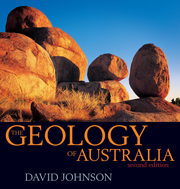Book contents
- Frontmatter
- Contents
- Map
- Preface
- Acknowledgements
- Map of main localities mentioned
- Abbreviations and units
- 1 An Australian perspective
- 2 The Earth: A geology primer
- 3 Building the core of Precambrian rocks
- 4 Warm times: Tropical corals and arid lands
- 5 Icehouse: Carboniferous and Permian glaciation
- 6 Mesozoic warming: The great inland plains and seas
- 7 Birth of modern Australia: Flowering plants, mammals and deserts
- 8 The history and evolution of life on Earth
- 9 Eastern highlands and volcanoes barely extinct
- 10 Building the continental shelf and coastlines
- 11 Great Barrier Reef
- 12 Planets, moons, meteorites and impact craters
- 13 A geological perspective on climate change
- 14 Cycles in a continental journey
- Sources and references
- Figure sources
- Index
12 - Planets, moons, meteorites and impact craters
Published online by Cambridge University Press: 05 August 2013
- Frontmatter
- Contents
- Map
- Preface
- Acknowledgements
- Map of main localities mentioned
- Abbreviations and units
- 1 An Australian perspective
- 2 The Earth: A geology primer
- 3 Building the core of Precambrian rocks
- 4 Warm times: Tropical corals and arid lands
- 5 Icehouse: Carboniferous and Permian glaciation
- 6 Mesozoic warming: The great inland plains and seas
- 7 Birth of modern Australia: Flowering plants, mammals and deserts
- 8 The history and evolution of life on Earth
- 9 Eastern highlands and volcanoes barely extinct
- 10 Building the continental shelf and coastlines
- 11 Great Barrier Reef
- 12 Planets, moons, meteorites and impact craters
- 13 A geological perspective on climate change
- 14 Cycles in a continental journey
- Sources and references
- Figure sources
- Index
Summary
Earth is only one of a very large number of rocky spheres orbiting the Sun, and presumably only one of a vastly greater number in the Milky Way and galaxies beyond. In what ways is Earth unique, and do the other planets tell us something of our past and of our possible future evolution?
The Earth's natural satellite, our Moon, is visibly pockmarked with craters, evidence of massive bombardment by meteorites. When did it happen? How many meteorite impacts are preserved in Australia, and when did they strike? What role have meteorite impacts played in the geological and biological evolution of Earth?
EARTH IN CONTEXT
As a result of exploration by US and Russian space probes and missions to the Moon and nearby planets, we know much more about our neighbours than ever before. This chapter summarises some aspects of planetary and stellar geology, in order to place the Earth in its planetary context within the Solar System and describe the range of impact features that are so well preserved in the arid outback of Australia.
The Sun
The mechanism that maintains the enormous heat output of the Sun was a puzzle until the 20th century. The prevailing theory for hundreds of years was that the Sun was simply a huge fire, burning by chemical combustion. Then in the mid 19th century Lord Kelvin calculated that if the Sun were made of coal it would burn up in 5000 years – far too short a time considering evidence in the fossil record on Earth that the Sun has been heating our planet for hundreds of millions of years.
- Type
- Chapter
- Information
- The Geology of Australia , pp. 255 - 276Publisher: Cambridge University PressPrint publication year: 2009



